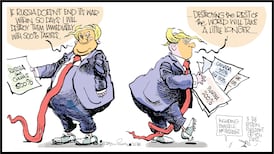There is some truth in Tánaiste Micheál Martin’s accusation that the media are “cheerleading” Sinn Féin to a “slam dunk” victory in the next election. Another truth is that he handed them the advantage of being the main Opposition party after the last election. Still leading the larger party, with more Dáil seats, he backed away from bringing Sinn Féin into government then on terms and conditions he will never be able to impose again. It was a historic failure of nerve.
For Martin, these are the good old days. He can take pride in his control of his party and his crafting of a coalition Government that maximised outcomes for Ministers, after a badly-led election campaign. He can also take the consequences.
It is entirely possible that Sinn Féin’s rise may still be staunched somewhere short of the gates of Government Buildings. But without a sea change in public opinion, it is likely the party will be the largest in the next Dáil by some distance.
Sinn Féin has two ambitions. One is a united Ireland and the other is a more left-wing economic agenda. The scale of both ambitions is moderating in plain sight as the prospect of government comes closer.
Keeping student fees down and reducing VAT would cost €3 billion we don’t have
Micheál Martin and Paschal Donohoe are responsible for this Government’s lethargy
Renters forking out €2,000 per month are paying the price for water charges debacle
James Browne has little power to fix the housing crisis. The status quo is in charge
[ The rise of Sinn Féin is fraying tempers on both sides of the BorderOpens in new window ]
In the 2016 election, Right2Change – the successor of Right2Water – was a broad, and it transpires a foolish, coalition of the left including trade unions and Sinn Féin. Only the Socialist Party stood outside, wary of Sinn Féin’s willingness to use left-wing votes to coalesce with right-wing parties. So it has proven to be; and that cuckoo is now big enough to throw the other chicks out of the nest at the next election.
The constituent parts of that alliance are now fodder for Sinn Féin as it tacks towards the centre. Its But its influence lives on as spending plans dependent on a dangerously concentrated tax base paying for every expectation.
Sinn Féin is increasingly leading a policy debate in which its rivals are defined by what they will or won’t do in relation to it.
It has not only moderated some of its own positions, it has become more moderate in relative terms, as the Government races across the centre and leftward, with engorged public expenditure in pursuit of a bigger State.
Paschal Donohoe has continuously held one or other of the two main economic portfolios in the government since 2016. His clarion call was that the centre must hold. He now accepts that the centre has shifted left. That’s some yoga move by a Fine Gael party that has evacuated the centre-right. Economic differences that used to scare the aspiring classes away from Sinn Féin are being erased, as Sinn Féin and the Government parties reverse towards each other. What Martin should know is that if there is a slam dunk election in the making, it is an inside job, and he is a chief architect and cheerleader.
He has considerable competition from Leo Varadkar, however. Nobody rivals him when it comes to the championing of unfettered expectations. From pensions in an ageing society for everyone from age 66, to mortgage interest relief in an inflating house market, to recurring energy subsidies for all, he is addicted to tax raising expenditure while talking up a tax-cutting budget. In its totality, it is a reckless bet on future corporation tax revenues. It also erases the difference with Sinn Féin while assuming centre-right voters will hang on for old time’s sake.
They might; but their aspiring offspring have long left the fold.
Varadkar has boosted Sinn Féin further by greening his own united Ireland credentials. The party in turn has dimmed its own – note how demands for a Border poll have evolved into talk about the need to prepare for one.
That leaves Martin as leader of Fianna Fáil, the Republican Party curiously sidelined on unity, but professing continued allegiance to coalition with Fine Gael.
There is perhaps one chink of light for Fianna Fáil, with Fine Gael unwilling to coalesce with Sinn Féin under any circumstances. Fianna Fáil may be preferred by some centre voters as the only available option to keep a watching eye over Sinn Féin in government.
Sinn Féin is a nationalist party before all else. The economic agenda remains secondary. In that its members are faithful followers of James Connolly and sincere imitators of his mistakes. One prospect that is disappearing is that of a Sinn Féin-led, left coalition. Sinn Féin seat gains will include the left seats it elected on its own transfers last time. To speak of Sinn Féin winning misses the point that what is at stake is changing.
Government is still a big leap for the party, and it is not a slam dunk. As a UK Labour treasury spokesperson under the leadership of the late John Smith MP, Mo Mowlam, was charged with leading her party’s fabled Prawn Cocktail Offensive in the City of London in the 1990s. Sinn Féin is on a similar charm offensive now. The Irish middle class has not made up its mind and has a long time to consider its options. But it doesn’t have much confidence in current management.















